Research Highlights
2012
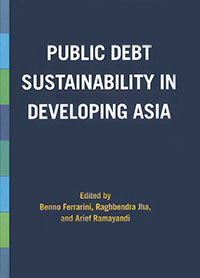
Public Debt Sustainability in Developing Asia
Benno Ferrarini, Raghbendra Jha, and Arief Ramayandi
To purchase this book go to the site below:
http://www.routledge.com/books/details/9780415522212/
Addressing the global financial crisis has required fiscal intervention on a substantial scale by governments around the world. The consequent buildup of public debt, in particular its sustainability, has moved to center stage in the policy debate. If the
Asia and Pacific region is to continue to serve as an engine for global growth, its public debt must be sustainable. Public Debt Sustainability in Developing Asia addresses this issue for Asia and the Pacific as a whole as well as for three of the most dynamic economies in the region: the People’s Republic of China, India, and Viet Nam.
The book begins with a discussion of the reasons for increased attention to debt-related issues. It also introduces fiscal indicators for the Asian Development. Bank’s developing member countries and economies. The sustainability of their debt is assessed through extant approaches and with the most up-to-date data sources. The book also surveys the existing literature on debt sustainability, outlining the main issues related to it, and discusses the key implications for the application of debt sustainability analysis in developing Asia. Also highlighted is the importance of conducting individual country studies in view of wide variations in definitions of public expenditure, revenues, contingent liabilities, government structures (e.g., federal), and the like, as well as the impact of debt on interest rates. The book further provides in-depth debt sustainability analyses for the People’s Republic of China, India, and Viet Nam.
Public Debt Sustainability in Developing Asia offers a comprehensive analytical and empirical update on the sustainability of public debt in the region. It breaks new ground in examining characteristics that are crucial to understanding sustainability and offers richer policy analysis that should prove useful for policymakers, researchers, and graduate students.
[top]
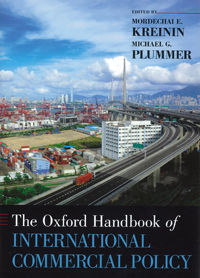
ASEAN Economic Integration: Driven by Markets, Bureaucrats or Both?
Hal Hill
To purchase this book go to the site below:
http://www.oxfordhandbooks.com/view/10.1093/oxfordhb/
9780195378047.001.0001/oxfordhb-9780195378047
The 10-member Association of Southeast Asian Nations, ASEAN, is arguably the most durable and successful regional grouping in the developing world. Established in 1967, it has contributed greatly to regional harmony and prosperity. The Association is characterized by great internal diversity, generally high economic growth, and a reluctance to establish a strong supra-national organizational structure. Beginning in 1976, the member countries have initiated a range of economic cooperation and integration programs, initially for merchandise trade, in the 1990s focusing on services trade, investment and labour, and in the past decade extending to some broader macroeconomic and financial measures, the latter in cooperation with its Northeast Asian neighbours. Its members have adopted what appear to be formal preferential trade arrangements, but in practice these have usually been multilateralized. ASEAN has informally practised what is sometimes termed 'open regionalism'. There is little likelihood in the foreseeable future of it adopting deep EU-style economic integration behind a common external trade regime.
[top]
2011

Malaysia's Development Challenges: Graduating from the Middle
Hal Hill
This book examines the various economic, political and developmental policy challenges that Malaysia faces in her shift from a middle income to high-income economy. This issue is of great interest to academics, policy makers and development practitioners in the developing world, particularly in middle-income economies where there is a widespread concern about the challenges of managing such a transition.
Malaysia is one of the developing world's greatest success stories. The book argues that as one of the developing world's most open economies, with a reputation for prudent macroeconomic management, Malaysia has achieved consistent growth since independence. It has moved from a largely resource-based economy to a multinational-led, export-oriented, industrial economy. Despite this success, Malaysia, like other developing countries, is currently at a crossroads in its development strategy; it is in danger of being unable to graduate to the level of more advanced economies - such as Korea, Taiwan and Singapore - but with the basis of its success at risk from competition from efficient, lower-wage countries - such as China, India and Vietnam. Moreover, there are new threats to the political stability and affirmative action programmes which have successfully held together a very racially diverse population.
[top]
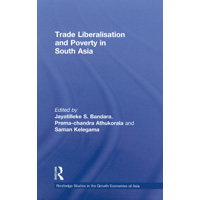
Trade Liberalisation and Poverty in South Asia
Prema-Chandra Athukorala
The link between trade liberalisation and poverty has arguably been one of the most debated topics in development policy debate. Existing studies on the subject have primarily used multi-country cross-sectional data, and there is a growing concern about the limitations of this approach in providing a sound empirical basis for informing the policy debate. These limitations point to the need for undertaking in-depth analyses within individual countries over time. In order to examine the connection between trade liberalisation and poverty, this book provides case studies of trade policy reforms and poverty reduction outcomes of seven countries in South Asia - Bangladesh, Bhutan, India, Maldives, Nepal, Pakistan, and Sri Lanka. The South Asia region allows for an excellent comparative study given the widespread emphasis on liberalisation reforms in the region over the past two decades, as well as highlighting significant inter-country differences in terms of the timing and comprehensiveness of reforms, and the heavy concentration of world poverty in the region. This book is a useful contribution to studies on South Asia, as well as International Trade and Development Economics.
[top]
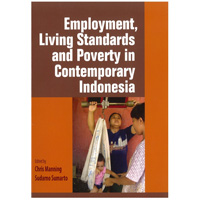
Employment, Living Standards and Poverty in Contemporary Indonesia
Chris Manning
Understanding the nexus between employment, living standards and poverty is a major challenge in Indonesia. Trends in poverty are heavily dependent on labour market opportunities and social spending in education and health. The question is how to create opportunities and spend money wisely - a subject of intense debate in Indonesia. The government has brought a renewed focus to poverty reduction since the end of the Asian financial crisis, especially under the current president, Susilo Bambang Yudhoyono. This book shows how Indonesia is travelling with regard to employment, social policy and poverty. It identifies promising new directions for strategies to alleviate poverty, some of which are already showing results
[top]
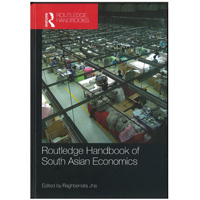
Routledge Handbook of South Asian Economics
Raghbendra Jha
To purchase this book go to the site below:
http://www.routledge.com/books/details/9780415553971/
The Routledge Handbook of South Asian Economics addresses the recent economic transformation in South Asia. Leading experts in the field look at the major economic achievements and challenges for the region and examine why economic development across the South Asia region has diverged so significantly since the early 1990s.
Providing a cutting-edge review of the economies of South Asia, the Handbook analyzes key growth areas as well as key structural weaknesses and policy challenges facing these economies. Furthermore, it anticipates trends and suggests corrective measures for the South Asian economic region. Sections focus on issues of human development, such as inequality, poverty and quality of schooling, and monetary and fiscal issues, particularly in light of the ongoing global financial crisis. Further sections discuss issues relating to employment and infrastructure, and on the experience of the region with international trade and financial flows, and environmental challenges.
Written by renowned and respected experts on South Asian economics, this Handbook will be an invaluable reference work for students and academics as well as policy makers interested in South Asian Studies, Economics and Development Studies.
[top]
